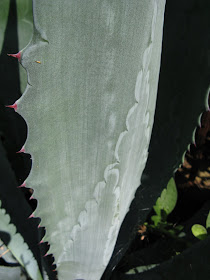Good ol' Echinacea purpurea with a Bumble Bee doing its duty.

I'm fairly certain this is Hibiscus 'Kopper King' -- an outstanding hybrid by the Fleming brothers of Nebraska.

One of the several dark-leaved Canna that are available these days. I almost find the clash of colours a little garish -- but to each his own.

Another shot of a back-lit Ensete leaf. I have a hard time resisting taking another picture of these plants every time I see them -- they are magnificent.

I believe the correct name of this plant is Canna 'Phasion' but it is also known as Tropicanna™ or 'Durban', 'Inferno' and several others. It's history is almost as colourful as the plant itself.

Of all the forms of Black-eyed Susan (Rudbeckia hirta), this one called 'Prairie Sun' is my favourite by far for its consistent form and height and outstanding colour.

This is another plant that fascinated me early on -- the Turtlehead or Chelone sp., a genus of four species native to much of eastern North America. Although some suggest otherwise, I think the flowers do look like a turtle's head. Our native species here in Ontario, C. glabra, has flowers that are usually a lighter pink (almost white) than the one pictured below, and can be found in sunny, moist locations.

Here's Sedum sieboldii 'Mediovariegatum' again, this time nicely back-lit.

Here's a pleasant pink Japanese Anemone, probably A. hupehensis, a valuable plant for the late summer garden, but yes, it does spread a little in good garden soil.

This Agave americana (Century Plant, American Aloe) caught my eye with the interesting "water mark" down along one side of a leaf. I know of some people using syrup or nectar of this plant as a healthful natural sugar substitute.

I can remember seeing this plant, the Castor Bean (Ricinus communis), for the first time many years ago, and being instantly impressed by its size 2-3m (7-10'), and colourful foliage. I'm not sure why this plant remains so elusive in the retail environment, as I find it irresistible.

Here's an interesting, back-lit shot of the seed-heads of Chasmanthium latifolium, the Northern Sea Oats. While it does seed itself around quite a bit, it is still a useful grass -- it is one that can certainly tantalize most of the senses on a quite summer evening.

This is a cool close-up of a flowers from Ligularia dentata. A biology professor could make good use of this to teach his/her students all the "intricate" parts of a flower! ;)

Finally, good ol' Pennisetum alopecuroides 'Hameln', the popular Fountain Grass in all its glory.

Here's to dirt under your nails -- summer is quickly coming to an end.
MPD, the coolplantsguy
Always enjoy your plant photography and plant selections. Quick question. Is the Pennisetum hardy to zone 5 or is it treated as an annual? Thanks
ReplyDeleteThanks Chen. The above Pennisetum is hardy to zone 4 or 5. It is the purple-leaved P. setaceum that is not hardy, and usually treated as an annual.
ReplyDeleteGreat photos! I'm always amazed at how many plants have acclimated themselves to such a large range geographically. I'm in Georgia, and share many of the plants you've shown in Ontario!
ReplyDeleteThanks Tim. The Niagara Parks Commission has been doing a great job at working in tropicals and "tender perennials" into their designs over the last few years.
ReplyDelete